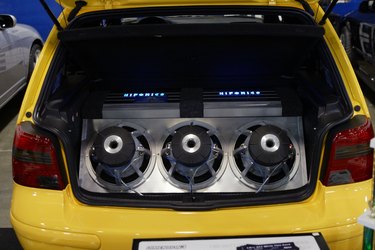
Tuning a ported subwoofer is vital to its performance. Fortunately, lots of Web help exists for all aspects of subwoofer design for do-it-yourselfers. In the case of "tuning" a ported subwoofer box, there are two ways to do it: 1) mechanically, and 2) by mathematical equation.
Before getting to this point, though, know that determining the loudspeaker/driver that will be housed in the box/cabinet/enclosure is the first item to be determined. That said, at the point your subwoofer is ready to be constructed, here are the means to tune the box successfully.
Video of the Day
Video of the Day
Determining the Resonance Frequency for Round Ports
Step 1
Set the multimeter to measure current. Attach the multimeter in series between the subwoofer and the amplifier. Use the frequency generator to drive the subwoofer.
The impedance will dip to its lowest level for a ported subwoofer box. (It will peak at its highest level for a sealed enclosure.)
Step 2
At the resonance frequency, the meter will read the the highest result for ported subwoofer boxes. Adjust the port length if the measured resonance frequency is not the same as the predicted resonance frequency.
Step 3
Tune a ported subwoofer box to a specific frequency with the following equation: Fb = the desired tuning frequency of the enclosure in Hertz. Lv = the length of your port in inches. R = the inside radius of your vent tube. Vb = the internal volume of your enclosure in cubic inches. To convert cubic feet to cubic inches, multiply by 1728.
Other Port Configurations
Step 1
Divide the enclosure volume by the number of ports being used for multiple port designs. Use the result of this calculation as the Vb value in the formula below to find out how long each square port should be.
LV = [(1.463 x 10^7 x R^2)/(Fb^2 x Vb)] - 1.463 x R
Step 2
Calculate square ports/vents with the formula below. It provides the value of R to use in the formula above.
R = square root of (A/Pi)
A = the area of the square vent (height x width), and (Pi) is approximately 3.141592.
Step 3
Thiele/Small parameters yield the variables that determine a loudspeaker's performance characteristics. Therefore, even though their values look like Greek to anyone who doesn't use math in their daily life, it's easy to figure enclosure size...and tuning....with these measurements. Thiele/Small parameters, also known as T/S, are provided by virtually every manufacturer for every size loudspeaker/driver.
If such information is not provided with the loudspeaker (the driver + the cone), it is available online for every size component. Having those components and the T/S parameters dictates the size of the enclosure, or subwoofer box.
Fs = resonance frequency of the driver. Qes = Electrical Q of the driver at Fs. Qes measures the driver's tendency to resonate at Fs based on its electrical characteristics, i.e. magnet.
Qms = Mechanical Q of the driver at Fs. Qms measures the driver's tendency to resonate at Fs based on its mechanical characteristics, i.e. weight of the cone. Qts = Total Q of the driver at Fs. Combination of Qes and Qms, calculated as Qts = Qms_Qes/(Qms+Qes)) Re = DC resistance of the driver voice coil. Re is less than the driver's rated impedance (normally 8 or 4 ohms). Sd = Effective surface area of the driver. Roughly the area of the cone plus 1/3 of the surround. Vas = Equivalent air compliance. The volume of air that has the same compliance ("springiness") as the driver's suspension. Because less air is more "springy" than more air, a large Vas represents a "loose" suspension. Vd = Peak displacement volume. Vd = Sd_Xmax.